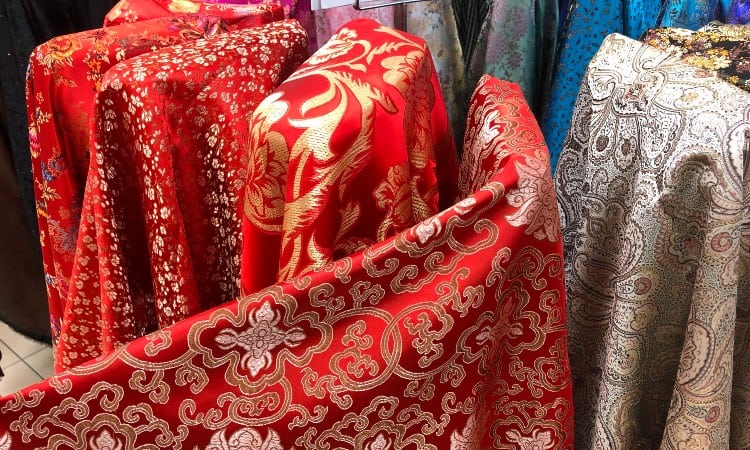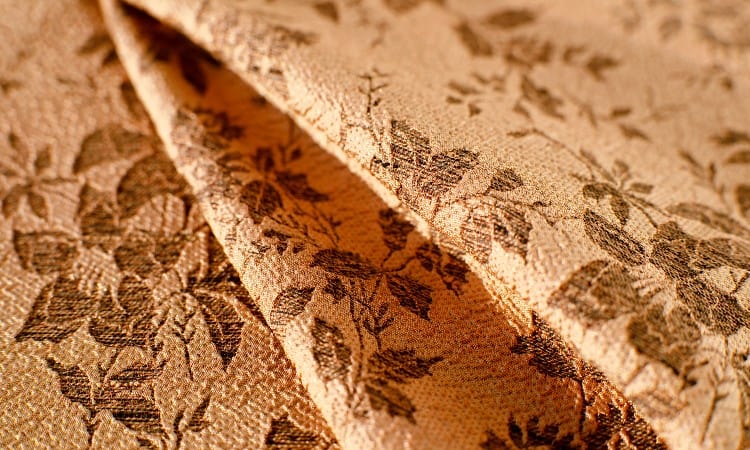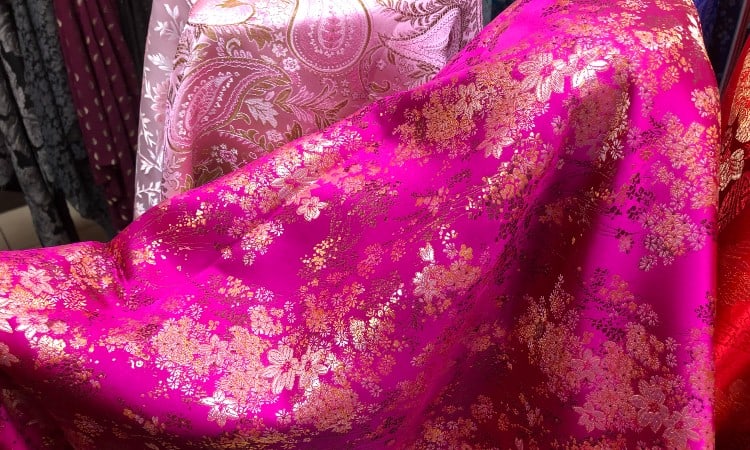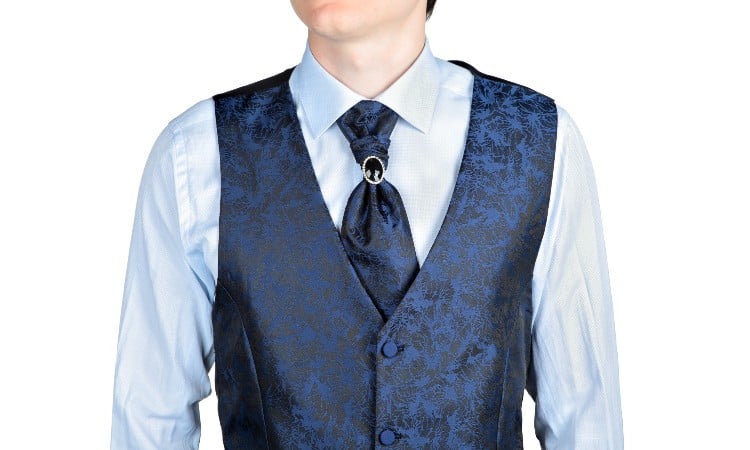One fabric guaranteed to catch my eye when shopping is a Jacquard. The pattern on the material shimmers as the light dances across the surface. Jacquard fabrics look so stylish and sophisticated. I’d love to use some in a project. But, what can you use it for? What is Jacquard fabric?
Jacquard fabric is a textured material with a distinctive woven pattern. Textiles classed as Jacquard include brocade, damask, and tapestry. The fabric can be made from silk, cotton, and synthetic fiber and has many uses. Heavier jacquards are popular for upholstery, and lightweight options are used for formal wear and bedding.
In this article, we’ll look at the history of Jacquard fabrics. From their early beginnings in the middle ages to modern-day usage. Find out how to identify a Jacquard and what you can use it for.

Quick Navigation
What Is Jacquard Fabric?
Jacquard fabric is a type of woven or knit material with an all-over pattern. The pattern is made up of different colored yarns or by varying the stitch type. It’s actually woven into the material and becomes part of the fabric surface.
To be classed as a Jacquard fabric, the material has to be woven on a Jacquard loom. The raised sections are formed when the computer-controlled loom selects a pattern of stitches which are then woven into the fabric. Any fabric with a printed or stamped design or pattern is not a Jacquard.
Patterns on Jacquard fabrics are slightly raised. They stand proud against the rest of the fabric and are known as embossed designs. If you run your fingers across the surface of the textile, you’ll feel the raised elements as you work your way across the fabric. These raised portions are a key identifier for Jacquard fabrics.
Many Jacquard materials have long strands of yarn, called floats, on the back. In a similar way to knitting, these are created as the pattern changes to a different color and then picks up the original color later in the design.
You can also get some Jacquard fabrics with a reversed version of the pattern on the rear of the fabric. This shows a negative image. Rather than being raised, the design shows in dips along the back of the material.
Because of the nature of the weave, some Jacquard fabrics can be reversible. With the design visible on both sides of the fabric, it doesn’t matter which side you use. Knit versions of Jacquard are often identical on both the right and wrong sides, making the choice entirely up to you.
Over time Jacquard has become the go-to generic term for any embossed fabric, whether made from cotton, silk, or polyester. Coming under the Jacquard umbrella are fabrics like matelassé, brocade, and damask.
History of Jacquard Fabric

The history of Jacquard begins in the middle ages. Back then it was known as brocade. As an intricately designed fabric made from wool, linen, and later silk, brocade was a symbol of wealth and social standing.
It was incredibly labor-intensive to produce brocade fabrics, making the finished material very expensive. Only affordable by royalty or the very rich, brocades became synonymous with affluence.
The main reason for the high cost of the fabric was the amount of time it took to weave it. Brocade was made on a draw loom that needed two people to work it. There would be a weaver and a draw boy. It was the responsibility of the weaver to call instructions about what yarn needed to be woven next. They would also say how many of each yarn should be used.
Acting on the commands of the weaver, the draw boy would move the yarns across the loom. Climbing over it and drawing the yarns behind them. Following the color sequence exactly as the weaver told them, they would weave the colors and threads into a piece of fabric.
As you can imagine, the process was slow and time-consuming. It was also incredibly dangerous for the draw boy. Not only was it back-breaking work, but looms before modern-day safety devices were introduced were known to cause life-altering injuries—even fatalities.
It was a system fraught with difficulties. There was a high potential for miscommunication. With so much going on, it would be easy for the draw boy to mishear the color. Or to weave too much of one thread.
Add communication issues to perilous working conditions, and it’s no wonder making brocade was slow and laborious. It would take one team of a weaver and draw a boy a full day to make two inches of brocade.
Although weaving was revolutionized in the 18th century with the introduction of powered looms, they were only able to weave plain fabrics or simple patterns. Brocade was still too complicated for a machine to handle.
It took a former draw boy to change that. In 1804, Joseph Marie Jacquard introduced a device known as a Jacquard loom. The name is a little misleading as Jacquard didn’t re-invent the loom. Basically, he came up with an add-on device for existing looms.
Jacquard’s system used punch cards to program looms to carry out the work of the draw boy. Patterns would be punched onto paper cards which were then loaded into Jacquard’s punch card reader. Holes punched into the cards would then dictate which yarns got woven where.
A pretty simple idea that led to the introduction of the world’s first programmable machine. You can still find gadgets using the punch card system. Think about the flatbed domestic knitting machines from the 1970s or some music boxes.
The introduction of the punch card system was so effective that it reduced the time it took to produce intricate fabrics like brocade. Almost overnight, the cost of brocade dropped significantly. For the first time, these durable fabrics with fancy decorative designs were available to anyone, not just the wealthy.
Jacquard’s idea was so revolutionary that it led to the development of another device. One that plays a large part in our everyday lives.
Charles Babbage used Jacquard’s device as the basis for his breakthrough in modern science. He used the punch card system to design the world’s first computer.
These days, Jacquard looms have moved on from punched cards. In fact, you could say they’ve come full circle. They now use computer programs to control the weave of patterns.
Which I think is cool. It shows the symbiosis of two seemingly separate inventions and how they can work together to improve not only fabric production but our lives too!
Without Jacquard’s loom, we might never have had computers. If Babbage hadn’t invented the computer, we may never have had computerized programs. For creating patterns or for reading articles on the internet.
I think we owe a quick nod of thanks to both Jacquard and Babbage. Without them, the production of Jacquard fabrics would still be time-consuming and expensive.
How Is Jacquard Fabric Made?

Jacquard fabric can be made from a range of fibers, including cotton, silk, acrylic, and polyester. They can be woven on Jacquard looms, or you can get Jacquard knits made on knitting machines. In both options, a computer program controls the pattern embedded into the fabric.
The first stage in the production process is to choose the fiber content for the material. Jacquard fabrics can be 100% natural or 100% synthetic. They can even be a blend of more than one type, like polycotton.
Chosen yarns are either placed on a loom to be woven or on a knitting machine to be knitted. Then, the manufacturers choose the pattern they want on the fabric. They take the pattern from thousands of designs available for the Jacquard loom. Textile designers can even create new ones if they don’t see one they like.
Next, the loom is switched on and it begins to weave the threads according to the pattern program. Once the fabric is complete, it is removed from the loom.
Sometimes manufacturers will add special finishes to the material. Things like fire resistance or UV protection, for instance. The kind of finish they add is determined by the expected use of the material.
What are the Different Jacquard Fabrics?

As mentioned earlier, the term Jacquard can be used as a generic term. It can refer to any material with an intricate, embossed pattern.
Before the advent of the Jacquard loom, these different textiles would have been known by their original names. Some of which, like brocade, date back centuries. Let’s take a look at the different materials we know as Jacquard fabrics today.
Brocade
 Originally made from linen and wool, brocade fabric dates back to the middle ages. It was a luxury fabric enhanced with silk by Byzantine craftsmen to make a sumptuous fabric fit for royalty.
Originally made from linen and wool, brocade fabric dates back to the middle ages. It was a luxury fabric enhanced with silk by Byzantine craftsmen to make a sumptuous fabric fit for royalty.
These days brocade can be made from synthetic fibers and is the most popular form of Jacquard fabric. It’s common to find a brocade pattern in two colors. However, you can find examples containing as many as five.
Although it’s non-reversible, brocade is an awe-inspiring material suitable for evening wear and fancy apparel. Add a metallic thread to the mix and you have a lavish textile fit for a modern-day ball gown.
Brocatelle
 This one is very similar to brocade. The main difference between the two, brocade can be made on any loom capable of weaving fabric. Whereas brocatelle has to be produced on a Jacquard loom. This is because the pattern of brocatelle is more intricate and complicated than its brocade cousin.
This one is very similar to brocade. The main difference between the two, brocade can be made on any loom capable of weaving fabric. Whereas brocatelle has to be produced on a Jacquard loom. This is because the pattern of brocatelle is more intricate and complicated than its brocade cousin.
Distinctive puffed-up sections are an identifying factor for a brocatelle fabric. It tends to be non-reversible and has a similar feel to damask. Fibers for this one include silk, cotton, and rayon. As a heavier Jacquard, this type is more often used in upholstery.
Cloque
This Jacquard has a slightly puckered appearance. The pattern is raised and resembles quilting. Pronounced “clokee”, the word comes from the French for blister.
Made in a slightly different way to other Jacquards, this one is created through shrinkage. Natural fibers contained within the fabric are shrunk during production, resulting in a material covered in blister-shaped bumps.
Traditionally made from wool, silk, rayon, or cotton, the cloque Jacquard is ideal for home décor and suit jackets. You can also make skirt suits from it.
Damask
 Originally from Damascus, a damask fabric has an intricate pattern that is reversible. Normally made from a single color, albeit with subtle shade differences, damask can be made from silk, wool, linen, cotton, and synthetic materials.
Originally from Damascus, a damask fabric has an intricate pattern that is reversible. Normally made from a single color, albeit with subtle shade differences, damask can be made from silk, wool, linen, cotton, and synthetic materials.
Although the pattern appears the same on both sides of the fabric, the color shading of the background and raised sections will be reversed. This can mean either side of the material can be used as the right side.
Finer than brocade, damask is smooth and lustrous to the touch. Most often used in home décor, this Jacquard fabric can also be used for occasional wear like evening wear or items with a certain amount of structure or rigidity.
Matelassé
In a similar way to cloque, matelassé has a padded or quilted appearance. As with many fabrics, the name comes from its French origins. Matelassé is French for quilting.
Designed to resemble the hand-stitched quilts from the Provence region of France, matelassé is a heavy textile with the look and feel of a padded quilt. Only it isn’t padded at all. The quilted effect is created on a Jacquard loom.
You’ll find matelassé in bedding, throw pillows, and pillow shams. Most matelassé fabrics are 100% cotton, but they can be found in polycotton. You can sometimes find matelassé made using chenille.
Tapestry
Tapestry fabrics have been around for generations. The earliest examples have been dated back to the 13th century. As a form of Jacquard, tapestry fabric has a raised surface. It’s slightly different from the other Jacquards on this list, though.
Sometimes tapestry fabric looks more like a carpet than a Jacquard. Primarily used for wall hangings, tapestry designs can range from pictorial scenes depicting wildlife to intricate patterns using swirls, circles, or floral imagery.
This one can be used for floral upholstery or outerwear. Usually woven from wool, tapestry material can also be made from polyester, nylon, and sometimes acrylic.
What Is Jacquard Fabric Used For?

Jacquard fabrics can be used for all sorts of projects. From upholstery to haute couture, there’s a Jacquard that will fit the bill.
From tablecloths to bedding or upholstery to formal wear, the intricate designs on a Jacquard fabric make it the perfect choice for items needing a touch of class. Just imagine a tablecloth at a wedding reception in damask linen. It will scream pure sophistication and elegance.
With so many Jacquard fabrics to choose from, it can be tricky to pick the right one. The key is to make sure you pay attention to the thickness of the fabric.
Some Jacquard fabrics are better suited to upholstery than apparel simply because they can be a bit stiff. Similarly, the lighter-weight Jacquards made from silk or rayon could be the perfect fabric for an eye-catching prom dress.
Where to Buy Jacquard Fabric
You can buy Jacquard fabric from most local fabric retailers and specialist home décor outlets. Where you buy it from will depend on what you want the Jacquard for. As we’ve seen earlier in this article, Jacquard can be used for furniture and apparel.
Buying locally is a good idea if you aren’t sure what type of Jacquard you need. Your local fabric outlet will be able to advise you. So too, will the home décor section at your local department store. The staff are there to help you make the right choice, so don’t be afraid to ask for their guidance.
Online stores also sell Jacquard fabric. Although, you may find it harder to gauge the best use for the fabric if you can’t see and feel it in person. It’s always a good idea to contact the online store before purchasing. That way, you can ask for a sample or check with the retailer that it will be suitable for what you have in mind.
Jacquard Fabric by the Yard
The cost of Jacquard fabric by the yard will vary according to the type of material you are buying. You’ll also find the fiber content will make a difference too.
Jacquard fabric is an umbrella term for any fabric with a raised or textured pattern. As well as being a material made from synthetic fiber, natural fiber, or a combination of both, Jacquard pricing can range from as little as $4 per yard to $20 per yard.
Your location and the outlet you are buying the fabric from will also make a difference. A high-end store in a large metropolis will charge more for Jacquard than a smaller retailer in a smaller city.
Similarly, an online outlet may charge less or offer substantial discounts for bulk purchases. Although you may find shipping costs outweigh any savings if you shop online.
To get the best price for Jacquard, make sure to shop around. That way, you’ll be able to see what Jacquard fabrics are going for in your area before you commit to purchasing any.
How to Care for Jacquard Fabric
Caring for Jacquard fabrics depends on the fiber content and type of fabric you are dealing with. Generally, you should always check the care label on the item before attempting to clean it.
This is especially important if your Jacquard is particularly ornate. Intricate designs and delicate fibers are the main reason many manufacturers mark their Jacquard fabrics as dry clean only.
But what happens if you don’t have the care label anymore? There are some generic cleaning tips you can use for most Jacquards. However, it’s not always easy to tell what a Jacquard is made from.
Adding a non-washable fabric to a washing machine could end in disaster. If you are in any doubt about your Jacquard, it may be safer to have it dry cleaned. Not only will this ensure delicate patterns are not damaged by water or heat, but it will also keep them away from objects likely to cause snagging. Things like zippers on other garments, for instance.
If dry cleaning isn’t an option, or you feel your Jacquard is sturdy enough, you can wash it as long as you take care. For best results and to limit potential damage, always use a cold setting on your washing machine. Or better still, hand wash the Jacquard. That way, the washing machine can’t snag the fabric and cause pulls in the threads.
Never wring your Jacquard, regardless of the type. Jacquard may be durable, but depending on the fiber content, it can also be delicate. Silk or rayon-based Jacquard will not take kindly to being squished harshly.
Ironing Jacquard should be avoided if possible. However, if absolutely necessary, you can iron your Jacquard fabric on the wrong side. This will prevent any damage to the raised parts of the pattern. Pressing on the right side could flatten the material and remove the sheen.
Conclusion
A Jacquard fabric is one with a raised pattern or embossed design. The pattern is woven into the fabric, not printed or stamped. Jacquard fabrics are known to be luxurious and stylish. They can add a hint of sophistication to any room or outfit.
Have you ever used Jacquard fabrics for your projects? Has this article encouraged you to give them a try? Let me know in the comments.